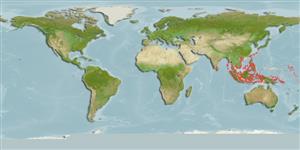Teleostei (teleosts) >
Eupercaria/misc (Various families in series Eupercaria) >
Scaridae (Parrotfishes) > Scarinae
Etymology: Scarus: Greek, skaros = a fish described by anciente writers as a parrot fish; 1601 (Ref. 45335).
More on author: Bleeker.
Environment: milieu / climate zone / depth range / distribution range
Ecology
Marine; reef-associated; depth range 10 - 30 m (Ref. 90102). Tropical; 30°N - 9°S
Indo-Pacific: Moluccas in Indonesia, Philippines, Ryukyus in Japan and Palau.
Size / Weight / Age
Maturity: Lm ? range ? - ? cm
Max length : 31.0 cm TL male/unsexed; (Ref. 9710)
Dorsal
spines
(total): 9;
Dorsal
soft rays
(total): 10;
Anal
spines: 3;
Anal
soft rays: 9. Males resemble S. bowersi but differs in that the tan area of S. bowersi does not extend as far back as the anal fin (Ref. 1602). Initial phase has a distinctive black spot at front of the anal fin and yellowish tail and soft dorsal fin.
A rare species found in coastal and outer reefs with dense coral cover (Ref. 9710); often silty habitats (Ref. 48636).
Life cycle and mating behavior
Maturity | Reproduction | Spawning | Eggs | Fecundity | Larvae
Oviparous, distinct pairing during breeding (Ref. 205).
Parenti, P. and J.E. Randall, 2000. An annotated checklist of the species of the labroid fish families Labridae and Scaridae. Ichthyol. Bull. J.L.B. Smith Inst. Ichthyol. (68):1-97. (Ref. 35918)
IUCN Red List Status (Ref. 130435)
Threat to humans
Harmless
Human uses
Fisheries: commercial; aquarium: commercial
More information
ReferencesAquacultureAquaculture profileStrainsGeneticsElectrophoresesHeritabilityDiseasesProcessingNutrientsMass conversion
Tools
Special reports
Download XML
Internet sources
Estimates based on models
Preferred temperature (Ref.
123201): 25.4 - 29.1, mean 28.6 °C (based on 242 cells).
Phylogenetic diversity index (Ref.
82804): PD
50 = 0.5000 [Uniqueness, from 0.5 = low to 2.0 = high].
Bayesian length-weight: a=0.01023 (0.00436 - 0.02401), b=3.09 (2.90 - 3.28), in cm total length, based on LWR estimates for this Genus-body shape (Ref.
93245).
Resilience (Ref.
120179): High, minimum population doubling time less than 15 months (Preliminary K or Fecundity.).
Fishing Vulnerability (Ref.
59153): Low vulnerability (21 of 100).
Nutrients (Ref.
124155): Calcium = 54.5 [30.3, 94.0] mg/100g; Iron = 0.771 [0.494, 1.316] mg/100g; Protein = 18.1 [15.9, 19.9] %; Omega3 = 0.0589 [, ] g/100g; Selenium = 21.2 [10.9, 39.2] μg/100g; VitaminA = 49.8 [12.3, 196.1] μg/100g; Zinc = 2.44 [1.74, 3.34] mg/100g (wet weight);
